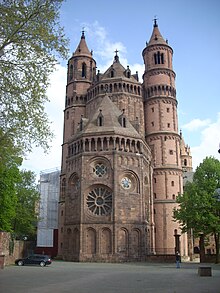Konrad II (Worms)
Konrad II , also Konrad von Sternberg († January 18, 1192 ) was Bishop of Worms from 1171 to 1192 and had today's westwork of Worms Cathedral built.
Origin and family
He came from the Frankish noble family of the Lords of Sternberg , the parents are not known. His nephew was the later Bishop of Worms and Mainz counter-archbishop Leopold II von Schönfeld († 1217). The Würzburg Bishop Berthold II von Sternberg († 1287) is a relative of the same noble family.
Live and act
Konrad von Sternberg had close ties to Emperor Friedrich Barbarossa , who appointed him Bishop of Worms in 1171 after the death of his predecessor Konrad I. Before that he was provost of the Cyriakus monastery in Worms-Neuhausen .
The emperor used Bishop Conrad II in various ways for his court services and apparently had great confidence in him. In the year he took office, he sent him to Constantinople to negotiate the planned marriage of a daughter of the Eastern Roman emperor Manuel I with his son.
At the end of 1176 he accompanied the ruler, who had been excommunicated since 1160 , to Rome to meet with Pope Alexander III. to settle that matter and end the schism supported by the emperor . This succeeded in 1177, Bishop Konrad played a decisive role in the reconciliation. In Germany, Emperor Friedrich Barbarossa often stayed with him in Worms. As a result, several Worms clergy were admitted to the court chapel and court clerics Barbarossa also increasingly acquired benefices in Worms. In 1179 Konrad II appeared at the Third Lateran Council . In this context he was ordained bishop - presumably in Rome.
Despite various claims for the empire and the ruler, the shepherd also looked after his diocese. A particular concern of his was the completion of the Worms cathedral, whose construction his predecessor Burchard II. Began in 1130 and Conrad I had been continued. Between 1171 and 1181, Konrad II had the westwork that still exists today, and on May 2, 1181 he solemnly consecrated the cathedral in the presence of the emperor.
On one of his visits to Worms in 1184, Friedrich Barbarossa granted the city extensive privileges, which were affixed to a gilded copper plate above the northern cathedral portal. Since 1981 there has been a new bronze plaque and a seated figure of the emperor, made by Gustav Nonnenmacher (1914–2012), as a souvenir.
In 1190 the bishop also advanced to provost of the St. Severus Boppard monastery , which he held until his death. In the same year he decided on behalf of Emperor Heinrich VI. a dispute between the monasteries Otterberg and Münsterdreisen about the supervision of the convent at Enkenbach . Also in 1190 he received the bailiwick of Dirmstein from the emperor for inheritance, from which one of the most important worldly possessions developed for the bishopric of Worms , which it owned until it was dissolved; u. a. later the summer residence of the prince-bishops was located here .
Konrad II died on January 18, 1192 and was buried in a stone coffin in the west choir of the cathedral, which he built, in front of the Laurentius altar. The grave was discovered in 1886 and examined archaeologically. The bones were completely preserved. Various additions were removed and are now in the city museum , u. a. a pontifical shoe .
literature
- Friedhelm Jürgensmeier : The diocese of Worms. From Roman times to its dissolution in 1801 (= contributions to the history of the Mainz church. Vol. 5). Echter, Würzburg 1997, ISBN 3-429-01876-5 , pp. 40-42.
- Friedrich Zorn: Worms Chronicle (= library of the literary association in Stuttgart. 43). With the additions of Franz Berthold von Flersheim, edited by Wilhelm Arnold . Litterary Association, Stuttgart 1857, p. 57 u. 59 .
- Johann Friedrich Schannat : Historia Episcopatus Wormatiensis. Volume 1. Varrentrapp, Frankfurt am Main 1734, pp. 359-362
Web links
Individual evidence
- ↑ Johannes Simon: Status and origin of the Upper Rhine bishops of the Mainz church province in the Middle Ages. Hofbuchdruckerei, Weimar 1908, p. 19 , (Bonn, University, dissertation, 1908).
- ↑ Friedhelm Jürgensmeier: The Diocese of Worms. From Roman times to the dissolution in 1801. 1997, p. 44.
- ↑ Worms Cathedral web portal ( Memento from March 2, 2017 in the Internet Archive )
- ^ Karlheinz Rothenberger, Karl Scherer, Franz Staab (ed.): Palatinate history. Volume 1. Institute for Palatinate History and Folklore, Kaiserslautern 2001, ISBN 3-927754-43-9 , p. 234, (detail scan) .
- ↑ On the privileges of 1184
- ↑ Ferdinand Pauly : The monasteries St. Severus in Boppard, St. Goar in St. Goar, Liebfrauen in Oberwesel, St. Martin in Oberwesel (= Germania Sacra . NF 14: The dioceses of the church province of Trier. The archbishopric of Trier. 2). de Gruyter, Berlin et al. 1980, ISBN 3-11-008001-X , (digital scan) .
- ^ Franz Xaver Remling : Documented history of the former abbeys and monasteries in what is now Rhine Bavaria. Part 2. Christmann, Neustadt an der Haardt 1836, p. 140 .
- ^ Website on the history of Dirmstein
- ↑ Anzeiger des Germanisches Nationalmuseums. Vol. 2, No. 1, 1887, ISSN 1430-5496 , p. 14 .
- ^ Heinrich Boos (Ed.): Monumenta Wormatiensia. Annals and chronicles (= sources on the history of the city of Worms. Part 3). Weidmann, Berlin 1893, p. 39 .
- ↑ Joseph Braun : The liturgical garment in Occident and Orient according to origin and development, use and symbolism. Herder, Freiburg (Breisgau) 1907, p. 403 .
| predecessor | Office | successor |
|---|---|---|
| Konrad I. |
Bishop of Worms 1171–1192 |
Henry I of Maastricht |
| personal data | |
|---|---|
| SURNAME | Konrad II. |
| ALTERNATIVE NAMES | Konrad von Sternberg |
| BRIEF DESCRIPTION | Bishop of Worms |
| DATE OF BIRTH | 12th Century |
| DATE OF DEATH | January 18, 1192 |


